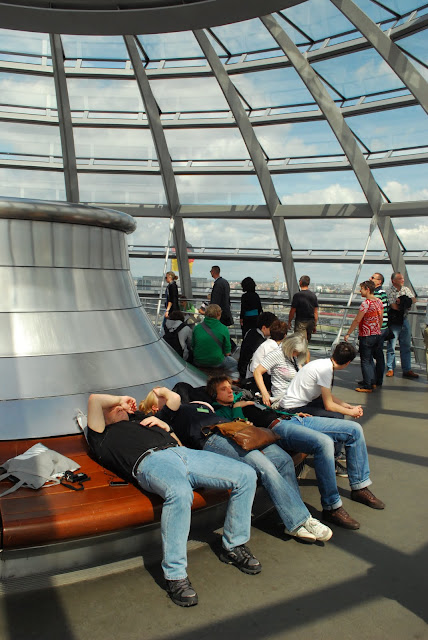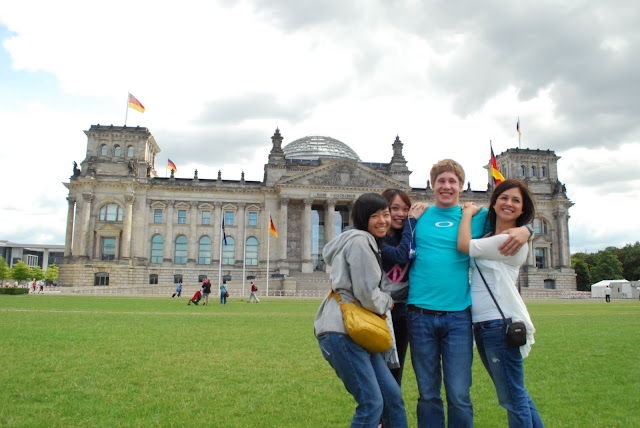Friday, 1 July 2011
This morning we woke early to keep our appointment at the Bundestag, the federal parliament of Germany. Jörn actually worked for a Bundestag member from the Ruhr area back in 2007, so we were able to secure an invitation to visit the parliament and watch an early-morning session of the Bundestag. We took a bus into the city center and Prof. Chamoni took the time to point out the major landmarks to me: the Brandenburg Gate, Unter den Linden (a large avenue), Humboldt University, and several other sites.
 |
| Security at the Reichstag. |
The modern Bundestag meets in the Reichstag, the great building which housed the parliament of the same name during the German Empire, Weimar Republic, and the Third Reich. A month after Adolf Hitler was appointed to the office of chancellor in January 1933, the building mysteriously burned. Communists were blamed, a move which directly led to the creation of the first concentration camps intended to house the huge number of political prisoners who were subsequently rounded up. The building suffered further damage during the Russian siege of the city at the end of the war. Troops flew the Soviet flag from the rooftop to signal the fall of the city and subsequently carved graffiti into the walls, traces of which are still visible today. Following the reunification of Germany at the end of the Cold War, the German Bundestag agreed to move back to Berlin from Bonn and to once again hold sessions in the Reichstag building. The building was renovated and now features an eye-catching glass dome and other modern upgrades.
We passed right through the security screening. While in Washington, D.C. we might have been patted down by a succession of black-suited agents with sunglasses, at the Reichstag we were merely escorted by a couple of long-haired and casually-dressed student types through a metal detector and given visitors´ badges. The guards even took a picture for us! (Though not a clear one.)
Inside, we were escorted to an upper-level viewing gallery which projected right out over the plenary chamber floor. Within a few minutes, the sparsely-attended morning session was underway, conducted all in German of course. I could make out some of the conversation while Jörn filled in the gaps. Apparently, a senior member of the Bundestag was celebrating his birthday this morning and the parliament wished to recognize him. However, he was not yet present! The errant representative arrived a few minutes later to hearty laughter and applause. Turning to more serious matters, the Bundestag took opened the floor to debate over continued funding of its long-standing internship program for international students, the measure eventually passing unanimously.
Next, we met with Jörn´s old boss, Herr Hempelmann. He has been a member of the Bundestag since 1994 and sits on various committees where he specializes in matters concerning European politics and economics, especially those involving the energy sector. Just the day before, the Bundestag voted to speed up the phasing out of nuclear energy in Germany by 2022, a result of the ongoing crisis in Japan. Last year, the current ruling coalition staged a “revolution” to prolong the use of nuclear energy and yesterday the energy minister called for another “revolution” to phase it out. His poor choice of words drew a number of comments and jokes from the other members.
Herr Hempelmann then spoke about the need to develop all viable alternative energy sources including wind and solar. I asked about the German position on Libya and the uncertainty over future oil exports to Europe. He said that issue was of great concern, not only to Germany but the EU as a whole. Decisions made in Berlin are increasingly shaped by decisions made in Brussels and one of the modern Bundestag´s chief tasks is to adapt the numerous EU laws made in Brussels into the German legal code. Crises in places like Libya and Japan and the threat of Russia cutting off the eastern supply of natural gas at whim underscore the need for Germany to develop as many clean, alternative fuel sources as possible.
Next on the agenda was a tour of the Reichstag dome. The glass dome acts as a skylight for the plenary chamber below while also allowing heat to escape and be recycled into other parts of the building. Additionally, a double-helix walkway allows visitors to ascend to the top and take in views of the surrounding city: to the south, the massive, refurbished American embassy next to the Brandenburg Gate; to the southwest, the stately Tiergarten; to the east, Alexanderplatz and the TV Tower.
 |
| The group rests after the long trek to the top of the Reichstag´s dome. |
 |
| Kylace, Clo, Meru, and I enjoy the view. |
 |
| Having a little fun with the dome´s reflective mirror... |
After our tour, we left the Reichstag and crossed the street to the Paul-Löbe-Haus which houses numerous offices and conference rooms for the Bundestag. Jörn worked in this building during his time in Berlin and said that Herr Hempelmann´s staff had already tried to persuade him to come back. We ate lunch in the cafeteria overlooking the River Spree, watching the tourist boats passing below.
 |
| Interior of Paul-Löbe-Haus |
In the afternoon we explored the surrounding area. Passing the chancellor´s offices, we boarded a bus and drove into the Tiergarten, Berlin´s Central Park of sorts. We climbed the Victory Column, a monument to Imperial Germany´s victories in the late 1800s which is decorated with the captured canons of Germany´s enemies. A few hundred stairs led to a viewing platform with more nice views of the city. Walking back towards the Reichstag, we passed the German president´s residence which had hosted the Chinese premier only the day before. We took a stroll down the red carpet and Clo pretended to give an interview with a passing news crew. Dr. Chamoni fed her a German line for the camera, “Ich liebe Berlin”.
 |
| Ryan gets the ladies... |
 |
| BEST in Berlin! |
 | |
| Our afternoon boat ride took us by the Chancellor´s office building. |
 |
| The new Berlin Hauptbahnhof just across the river from the Reichstag. |
We took a boat ride down the Spree past the Hauptbahnhof, the Reichstag, and the Berliner Dom (cathedral) until we reached a East-Berlin neighborhood near Alexanderplatz called Nikolaiviertel. There we took photos by a monument to Karl Marx (and Frederick Engels). Dr. Chamoni then invited us to join him for a Berliner Weisse, a local mixture of beer and flavored syrup. I couldn´t tell, but I´m sure Meruyert was secretly excited to finally find her “beer with juice” that she´s asked for at every bar from here to Duisburg! The drink comes in two colors: red and green. I tried the green which had a sweet, slightly-creamy flavor with perhaps a hint of melon. Group opinion pronounced it by far the better of the two.
Afterwards, we walked to Hackescher Markt. This neighborhood, only a 20-minute walk from Alexanderplatz, offers a variety of fashionable restaurants and cafes as well as chain clothing retailers.
For all its many faults, East Germany at least gave the world the charming figure called Ampelmann, a stylized walking figure used on all East Berlin crosswalk lights in place of the usual boring green and red lights. In Hackescher Markt we visited an Ampelmann store which sells every sort of object imaginable adorned with the little green figure.
After shopping, we walked to the hotel, changed clothes, and returned to Hackescher Markt for dinner. Italian night. We found a nice little place with good pizza and pastas and spent a couple of hours. The fresh olives were a nice touch. Afterwards, most of the group went to a bar where we had a few drinks in celebration of Clo´s birthday.

No comments:
Post a Comment